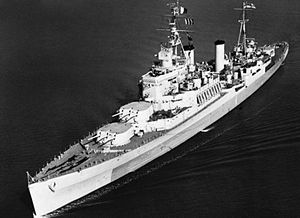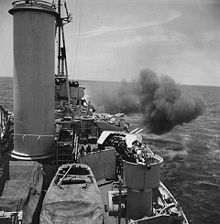HMS Uganda (66)
 Uganda underway
| |
| History | |
|---|---|
| Name | Uganda |
| Ordered | 1939 |
| Builder | Vickers-Armstrong, Newcastle upon Tyne |
| Laid down | 20 July 1939 |
| Launched | 7 August 1941 |
| Commissioned | 3 January 1943 |
| Identification | Pennant number: 66 |
| Honours and awards | Atlantic 1943, Sicily 1943, Salerno 1943, Mediterranean 1943[1] |
| Fate | Transferred to Royal Canadian Navy on 21 October 1944 |
| Name | Uganda |
| Acquired | 21 October 1944 |
| Commissioned | 21 October 1944 |
| Honours and awards | Okinawa 1945 |
| Renamed | HMCS Quebec 14 January 1952 |
| Namesake | Province of Quebec |
| Recommissioned | 14 January 1952 |
| Decommissioned | 15 June 1956 |
| Identification | Pennant number: C66 |
| Motto | Nos canons parleront (Our cannons shall speak)[2] |
| Fate | Arrived at Osaka, Japan, on 6 February 1961 for scrapping |
| Badge | Or, a maple leaf vert charged with a fleur-de-lis of the first[2] |
| General characteristics | |
| Class and type | Fiji-class light cruiser |
| Displacement |
|
| Length | 169.3 m (555 ft 5 in) |
| Beam | 18.9 m (62 ft 0 in) |
| Draught | 5.3 m (17 ft 5 in) |
| Propulsion |
|
| Speed | 33 kn (61 km/h; 38 mph) |
| Range | 10,200 nmi (18,900 km; 11,700 mi) at 12 kn (22 km/h; 14 mph) |
| Complement |
|
| Sensors and processing systems |
|
| Armament |
|
| Armour | |
| Aircraft carried | Two Supermarine Walrus aircraft, removed November 1943. |
HMS Uganda was a
Construction and career
HMS Uganda was one of the Ceylon sub-class (the second group of three ships built in 1939) of the Fiji-class cruisers, and built by
Home Fleet operations
In March 1943 after training at
Mediterranean Fleet operations
With her refit completed, she was sent to the
On the opening of
There being no dry dock available in the European Theatre that could handle the repairs, Uganda was sent to the US shipyard at Charleston, South Carolina. The heavily damaged ship, with only one of her four propellers working, proceeded across the Atlantic Ocean to Charleston, arriving on 27 November 1943. During the repairs, Uganda had two hangars designed for carrying Supermarine Walrus reconnaissance aircraft removed. These hangars were used for radio and radar equipment as well as crew amenities.
Transfer to Canada


While under repair the
Uganda's first assignment came shortly after her recommissioning. She was tasked to join the
As the
At
On 4 April 1945, the Canadian government changed the manning policy for all ships deploying to the Pacific theatre. All those heading to the Pacific would have to re-volunteer. Upon volunteering again, the serviceman would be eligible for 30 days leave in Canada before deployment.[12] Controversially this policy change was applied to those already there and Uganda's RCN crew were polled by the Canadian government on 7 May 1945 to determine whether they would volunteer for further duties in the Pacific War.[12][14] Widespread discontent had grown amongst the crew, due to poor living conditions and the lack of a Canadian identity for the ship[clarification needed] and the result saw 605 of her crew of 907 refuse to volunteer.[14] The crew of Uganda felt that they had volunteered for "hostilities only" (i.e., hostilities against Nazi Germany), but now found themselves fighting a different enemy in a quite different part of the world.
The vote on 7 May was held onboard Uganda and 605 crew out of 907 refused to volunteer for continuing operations against Japan. The
Uganda took part in Operation Inmate, a carrier raid on Japanese installations at Truk. Sailing on 12 June from Manus Island, the cruiser was among the ships detailed to bombard the island of Dublon. The force returned to Manus Island on 17 June. In July, Uganda, now part of Task Force 37, sailed to join up with the Americans performing carrier air strikes on the Tokyo area, arriving on 16 July. On 27 July, Uganda was relieved by HMS Argonaut.[15]
HMCS Uganda was detached from the US Navy's Third Fleet on 27 July when Argonaut arrived. Uganda proceeded to
HMCS Uganda remained on the Pacific coast following the war serving in a training capacity. The cruiser was
Return to service

Canada's entry into the
In February 1953, Quebec, with
Her unit name lived on in the form of HMCS Quebec, a cadet summer training centre for the Royal Canadian Sea Cadets. The training centre closed permanently after its summer 2012 operating season.[30]
References
Notes
- ^ Britain's Navy
- ^ a b Arbuckle, p. 97
- ^ a b c Macpherson and Barrie, p. 40
- ^ Rohwer, p. 255
- ^ Rohwer, p. 261
- ^ Rohwer, p. 262
- ^ Rohwer, pp. 264–265
- ^ Rohwer, p. 265
- ^ Rohwer, pp. 272–273
- ^ a b Milner, p. 154
- ^ Rohwer, p. 408
- ^ a b c Milner, p. 155
- ^ Rohwer, p. 415
- ^ a b Hastings (2007), p. 401
- ^ Rohwer, pp. 420, 422, 425
- ^ Milner pp. 155–156
- ^ Mutiny: The odyssey of HMCS Uganda
- ^ Butler, Malcolm. "The Uganda". CFB Esquimalt Naval & Military Museum. Archived from the original on 15 March 2011. Retrieved 3 January 2011.
- ^ "HMCS Quebec". The Crowsnest. Vol. 4, no. 5. Queen's Printer. March 1952. pp. 4–5.
- ^ "HMCS Quebec Commissioned in Esquimalt Ceremony". The Crowsnest. Vol. 4, no. 4. King's Printer. February 1952. p. 2.
- ^ "New Ships, New Guns for Canada's Navy". The Crowsnest. Vol. 4, no. 10. Queen's Printer. August 1952. p. 26.
- ^ "Quebec, Magnificent in Big NATO Exercise". The Crowsnest. Vol. 4, no. 11. Queen's Printer. September 1952. p. 2.
- ^ "East Coast Ships On Training Cruises". The Crowsnest. Vol. 5, no. 5. Queen's Printer. March 1953. p. 3.
- ^ Souvenir Programme, Coronation Review of the Fleet, Spithead, 15th June 1953, HMSO, Gale and Polden
- ^ "RCN to Take Part In Coronation, Review". The Crowsnest. Vol. 5, no. 4. Queen's Printer. February 1953. p. 2.
- ^ "South American Cruise Ends". The Crowsnest. Vol. 7, no. 1. Queen's Printer. November 1954. p. 2.
- ^ "Training Cruisers Return Home". The Crowsnest. Vol. 7, no. 6. Queen's Printer. April 1955. pp. 3–4.
- ^ a b "Cruisers Bought by Japanese Firm". The Crowsnest. Vol. 12, no. 11. Queen's Printer. September 1960. p. 3.
- ^ "Quebec Pays Last Visit to Halifax". The Crowsnest. Vol. 12, no. 12. Queen's Printer. October 1960. p. 3.
- ^ "NCSM Québec : la fin d'une grande famille". La Presse. 13 August 2012. Retrieved 1 December 2013.
Bibliography
- Arbuckle, J. Graeme (1987). Badges of the Canadian Navy. Halifax, Nova Scotia: Nimbus Publishing. ISBN 0-920852-49-1.
- ISBN 1-59114-705-0.
- Campbell, N.J.M. (1980). "Great Britain". In Chesneau, Roger (ed.). Conway's All the World's Fighting Ships 1922–1946. New York: Mayflower Books. pp. 2–85. ISBN 0-8317-0303-2.
- ISBN 978-1-5267-9327-0.
- ISBN 978-1-59114-078-8.
- Hastings, Max (2007). Retribution – The Battle for Japan, 1944–45. New York: Alfred A. Knopf. ISBN 978-0-307-26351-3.
- Macpherson, Ken; Barrie, Ron (2002). The Ships of Canada's Naval Forces 1910–2002 (Third ed.). St. Catharines, Ontario: Vanwell Publishing. ISBN 1-55125-072-1.
- Milner, Marc (2010). Canada's Navy: The First Century (Second ed.). Toronto: University of Toronto Press. ISBN 978-0-8020-9604-3.
- Murfin, David (2010). "AA to AA: The Fijis Turn Full Circle". In Jordan, John (ed.). Warship 2010. Naval Institute Press. ISBN 978-1-84486-110-1.
- Raven, Alan & Roberts, John (1980). British Cruisers of World War Two. Annapolis, Maryland: Naval Institute Press. ISBN 0-87021-922-7.
- ISBN 1-59114-119-2.
- ISBN 1-86019-874-0.
External links
- WWII cruisers at www.world-war.co.uk
- HMS Uganda at Uboat.net
- The Uganda Episode at Naval and Military Museum Archived 9 December 2020 at the Wayback Machine
